In late 2007, the Federal Reserve began various emergency lending programs, such as the Term Auction Facility, that increased reserves in the banking system. In 2008, the Federal Reserve implemented the first of several quantitative easing (QE) programs, purchasing large quantities of long-term Treasuries and mortgage-backed securities. These operations eventually expanded the Fed’s balance sheet to include more than five times the amount of securities it had prior to 2008. Currently, the Fed holds $4.5 trillion in assets, consisting mainly of long-term Treasury securities as well as the debt and the mortgage-backed securities (MBS) issued by Fannie Mae and Freddie Mac. (See Chart 1.)
These operations ultimately caused the Fed to create a new policy framework that replaced traditional market activity with bureaucratically administered interest rates. By paying billions of dollars in interest to large banks (and other financial institutions) to make it more attractive for them to place funds with the Fed than to lend in other short-term markets, this framework gives the Fed an abnormally large presence (by historical standards) in credit markets. The new policy structure is a dramatic shift from the past, making it very difficult for the Fed to adequately regulate the overall availability of credit in private markets without allocating credit to specific groups.
The Fed has begun to shrink its balance sheet, but the existing scheme ensures that it will maintain an abnormally large footprint in credit markets for years to come. Furthermore, Fed officials have not announced any plans to end the Fed’s interest on reserve policies or its special reverse repurchase program. To normalize monetary policy, thus restoring the market forces that the Fed has displaced, the Fed has to shrink its balance sheet and end these experimental programs. This Backgrounder explains the main differences between the Fed’s pre-crisis and post-crisis operations, and makes specific recommendations for Congress to help restore the Fed’s traditional operating framework.
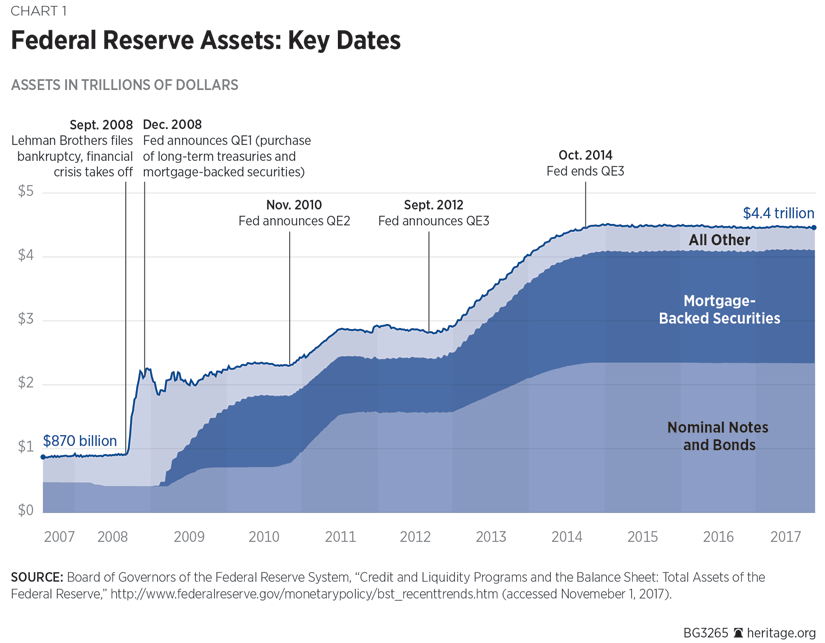
Traditional Monetary Policy Framework
A central bank exercises monetary control by regulating the economy’s overall liquidity (the availability of liquid, or cash-like, assets) to indirectly influence the economy’s general course of spending, prices, and employment. Prior to the 2008 financial crisis, the Federal Reserve exercised monetary control mainly through open market operations, that is, the buying and selling of short-term Treasury securities on the open (public) market.[REF] Many economists focus on the relationship between open market operations and interest rates, but that focus ignores the underlying mechanics of the Fed’s traditional operating framework.[REF]
The Fed conducted these operations with the specific intent of increasing or decreasing the amount of reserves—a highly liquid asset—in the banking system, thereby increasing or decreasing the amount of money that banks could lend. This system worked because banks need reserves to make new loans,[REF] and only the Federal Reserve can increase (or decrease) the total amount of reserves in the banking system.
Under this traditional framework, when the Fed wanted banks to create less money, it took reserves out of the banking system by selling the Fed’s own securities. These sales reduced the aggregate amount of money that banks could create because it caused banks to use reserves for buying securities from the Fed rather than for funding additional private loans. Conversely, when the Fed purchased securities on the open market it increased reserves in the system, thus enabling banks to create more money with new loans. When an individual bank did not have enough reserves to make more loans (create more deposits or currency), it would simply borrow those reserves from another bank. Thus, while the Federal Reserve decided the total amount of reserves in the banking system, private banks ultimately determined how those reserves were allocated throughout the system.
Traditionally, banks commonly lent and borrowed reserves to satisfy their legal (and precautionary) requirements. This activity took place in the federal funds market, so named because banks hold reserve balances at the Federal Reserve. Traditionally, the interest rate in this lending market, the federal funds rate, was a market-determined rate. In other words, private banks’ lending negotiations—not the Federal Reserve—determined the federal funds rate.[REF] While the Federal Reserve did not set the federal funds rate itself, it did set a target for the federal funds rate based on ensuring that overall liquidity was consistent with its broader macroeconomic goals. The Fed then conducted its open market operations in an effort to ensure that the federal funds rate stayed near the desired target.
Influencing Rates vs. Setting Rates. The Fed’s open market operations typically have a great deal of influence on the federal funds rate—especially over short intervals—because the Fed is the monopoly supplier of bank reserves. While the Fed determines the total quantity of reserves in the banking system, market forces (banks’ decisions based on their individual reserve needs) determined the distribution of reserves within the system in the traditional framework. This process allowed the Fed to rely on banks’ demand for reserves as a decent indicator of the demand for money (or, more generally, liquidity). The aggregate demand for reserves, in conjunction with the total supply, ultimately determined the federal funds rate.
By adjusting the supply of reserves in the system “just enough” to meet the demand for reserves at its chosen target, the Fed was (in theory) able to offset changes in demand without disrupting market forces.[REF] By adjusting the supply of reserves based on its federal funds rate target, the Fed regulated the overall flow of liquidity in an effort to meet its broader macroeconomic goals. In such a system, the target federal funds rate is merely a means to an end—it is a policy instrument but it is not a policy objective.
This policy framework depends on the Fed keeping a minimal footprint in the market for reserves, causing some economists to refer to the traditional framework as a reserve-scarcity regime.[REF] All else constant, a scarcity of reserve balances (relative to demand for reserves) results in a larger volume of reserve lending between banks. In such an operating environment, the federal funds rate conveys information based largely on conditions in private credit markets, as perceived by the private lenders and borrowers putting their capital at risk.
On the other hand, the Fed’s open market operations would have very little influence on the federal funds market if reserves were more attractive (on a regular basis) than other uses of funds. In such an environment, with plentiful reserves that have little opportunity cost, banks would find it unnecessary to borrow reserves and the federal funds rate would no longer be the result of the same market process. In fact, the enormous buildup in reserves during the 2008 crisis ultimately caused interbank lending markets to break down, and contributed to the Fed abandoning its traditional operating procedures.
Federal Funds Targeting Falls Apart
One of the very first signs of the financial crisis occurred in August of 2007, when France’s largest publicly traded bank, BNP Paribas, suspended withdrawals from three of its subprime mortgage funds.[REF] According to Ben Bernanke’s memoir of the crisis, he quickly ordered the New York Fed to buy “large quantities of Treasury securities on the open market” to flood the federal funds market with reserves.[REF] Soon, the Fed began allocating credit directly to certain firms, operations that also increased reserves in the system.[REF]
While some of these efforts may have kept certain financial firms afloat, the Fed hamstrung its overall efforts by sterilizing (offsetting) its liquidity operations.[REF] In particular, the Fed sold Treasury securities from its portfolio, thus taking reserves out of the system at the same time it was injecting reserves into the system. To the extent that there was an increased demand for liquidity, the sterilization process hindered the Fed from meeting that demand. Ben Bernanke provides the following account of the Federal Open Market Committee’s (FOMC’s) decision during its August 2008 meeting:
We were facing what might prove to be a critical question: Could we continue our emergency lending to financial institutions and markets, while at the same time setting short-term interest rates at levels that kept a lid on inflation? Two key elements of our policy framework—lending to ease financial conditions, and setting short-term interest rates—could come into conflict.
…Since April, we had set our target for the federal funds rate at 2 percent—the right level, we thought, to balance our goals of supporting employment and keeping inflation under control. We needed to continue our emergency lending and at the same time prevent the federal funds rate from falling below 2 percent.[REF]
Thus, the Fed was officially worried about meeting its overall macroeconomic goals and maintaining what control it had over the federal funds rate. In hindsight, this approach proved a critical mistake, but the Fed could have avoided the misstep by concerning itself with maintaining an adequate supply of liquidity for the economy as a whole.
For instance, total nominal spending, for which a statistical counterpart is nominal gross domestic product (GDP), tends to decline in an economic crisis as people pull back on spending. This decrease in total spending coincides with people holding larger money balances, thus resulting in a shortage of liquidity in the economy. As a matter of principle, it makes little sense to strive for bolstering the federal funds rate and hitting an inflation target while total spending is collapsing.[REF] Yet, the Fed took just this approach as nominal GDP growth slowed in 2007 and fell into negative territory in early 2008. (See Chart 2.)
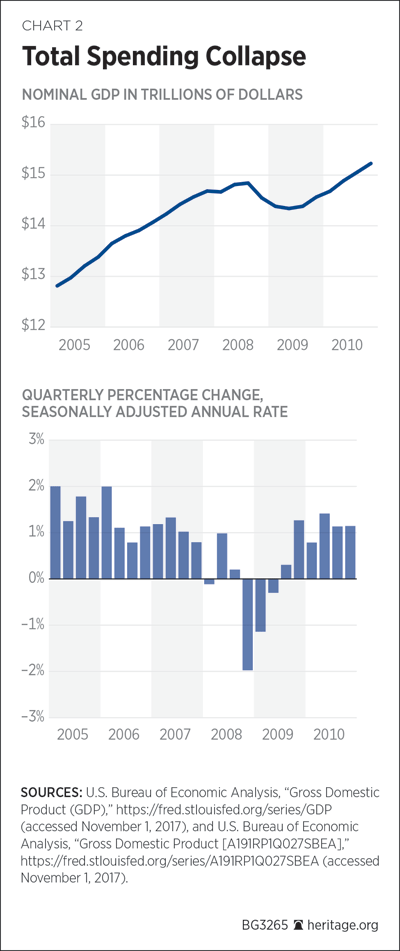
Furthermore, it is hardly controversial that the Fed cannot maintain any federal funds rate it desires, especially at a level inconsistent with the underlying natural (equilibrium) federal funds rate.[REF] If, for instance, the Fed tries to maintain an unnaturally high federal funds rate (a rate above the natural rate), it will lead to excessively tight monetary policy. All else constant, lending, overall spending, and the price level, will fall, and the drop in the demand for credit will lead to a lower federal funds rate.
Though it is very difficult to know the level of the natural federal funds rate at any given point in time, in hindsight it appears that the Fed was trying to maintain its target above the natural rate. The Fed clearly followed rates downward after September 2007 when it began lowering its target federal funds rate. (See Chart 3.) In little more than one year, the Fed had to lower its target from 5.25 percent to 1 percent. By the end of 2008, the Fed was still having difficulty hitting its target, so it scrapped the idea of a single target rate in favor of a target range (from 0 percent to 0.25 percent).[REF]
Regardless of whether it was the right approach, it is indisputable that the Fed wanted to sterilize its operations in order to maintain control over the federal funds rate and to achieve its macroeconomic goals. However, by the time it conducted its rescue of American International Group (AIG) in September 2008, the Fed had exhausted its ability to sterilize its emergency lending by selling Treasuries. From August 2007 to September 2008, the Fed’s holdings of Treasury securities had fallen from approximately $791 billion to $480 billion. (See Chart 4.) Given the size of its operations, the Fed believed it was nearly out of short-term Treasuries to sell.[REF]
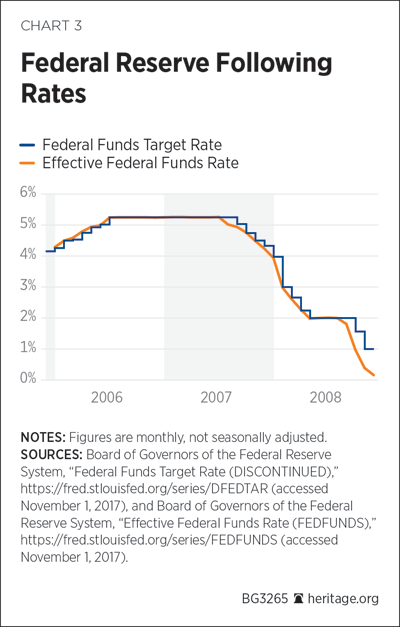
Post-2008 Monetary Policy Framework
As the 2008 crisis unfolded, the Fed changed its operating procedures dramatically. One well-cited example of this shift is the Fed’s massive QE programs, whereby the Fed expanded its balance sheet from less than $1 trillion to nearly $5 trillion.[REF] The Fed now holds approximately $4.5 trillion in assets that consist mainly of longer-term Treasury securities as well as the debt and the MBS of Fannie Mae and Freddie Mac. (See Chart 1.) Prior to the crisis, the Fed held, almost exclusively, short-term Treasuries. Another aspect of this new framework—the decision to pay interest on reserves—has at least as far-reaching implications as the QE programs.[REF]
Economists have long recognized that requiring banks to hold non-interest-bearing reserves acts as a tax on bank deposits and, therefore, on bank depositors.[REF] However, the Fed asked Congress for this authority for reasons that went well beyond merely offsetting the cost of reserve requirements.[REF] In his memoir, former Fed Chair Ben Bernanke explained the request as follows:
We had initially asked to pay interest on reserves for technical reasons. But in 2008, we needed the authority to solve an increasingly serious problem: the risk that our emergency lending, which had the side effect of increasing bank reserves, would lead short-term interest rates to fall below our federal funds target and thereby cause us to lose control of monetary policy. When banks have lots of reserves, they have less need to borrow from each other, which pushes down the interest rate on that borrowing—the federal funds rate.
Until this point we had been selling Treasury securities we owned to offset the effect of our lending on reserves (the process called sterilization). But as our lending increased, that stopgap response would at some point no longer be possible because we would run out of Treasuries to sell. At that point, without legislative action, we would be forced to either limit the size of our interventions…or lose the ability to control the federal funds rate, the main instrument of monetary policy.
So, by setting the interest rate we paid on reserves high enough, we could prevent the federal funds rate from falling too low, no matter how much lending we did.[REF] (Emphasis added.)
Thus, Fed officials believed that paying interest on reserves would help the Fed hit its interest rate target, and that the rate they paid on reserves would serve as a floor for the federal funds rate.[REF] Their intent had been to create a corridor system, whereby the interest rate on reserves is set below the central bank’s policy rate (the target federal funds rate in the case of the Federal Reserve).[REF] However, the Fed did not create a corridor system due to its conflicting goals.
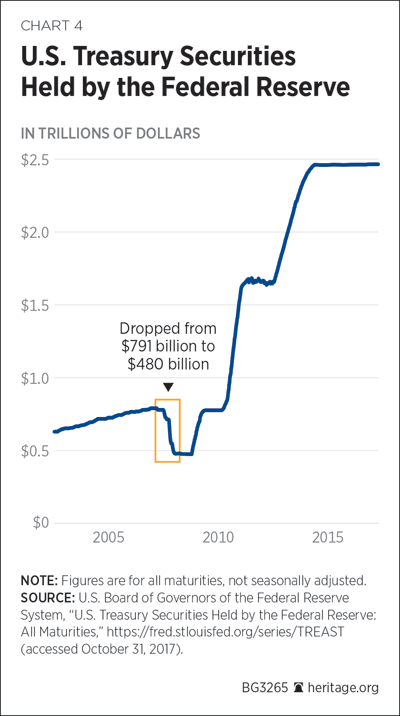
Above Market Rates: The Fed’s Leaky Floor. The Fed clearly wanted to pay interest on reserves to sterilize its operations, thus preventing the new reserves it was creating from flooding the federal funds market. Put differently, the Fed wanted to pay interest on excess reserves (IOER) so that banks would hold their excess reserves at the Fed rather than lend them in the federal funds market. The only possible way to accomplish this task, of course, would be to offer banks a higher rate of interest on excess reserves than they could earn by lending those reserves in the federal funds market. Thus, the IOER rate could not serve as a floor for the federal funds rate and sterilize the Fed’s operations.
When it began paying IOER in October 2008, the Fed set the IOER rate at 0.75 percent, well below the federal funds target rate of 1.5 percent. (See Chart 5.) In approximately two weeks, the Fed increased the IOER rate to 1.15 percent, reducing the spread between that rate and the prevailing federal funds target rate to 0.35 percent. By November 2008, both the federal funds target rate and the IOER rate were 1 percent. In December 2008, the Fed began setting a range for the federal funds target (an upper and lower limit) instead of a single target rate. The Fed held the IOER rate above the effective federal funds rate—the actual rate charged in the federal funds market—from the end of October 2008 through 2017. In fact, for roughly the entire period it has paid IOER, the Fed has set this overnight interest rate above virtually all short-term low-risk rates available on the market. (See Chart 6.) As of this writing, the IOER rate is 1.25 percent.
Another major change in the Fed’s monetary policy framework involves the creation of the overnight reverse repurchase facility (ON RRP). Historically, the Fed has conducted temporary open market operations by lending cash to primary dealers and accepting Treasuries as collateral in repurchase (repo) transactions, but this new program is different.[REF] The ON RRP program reverses these roles: Firms lend cash to the Fed and accept the Fed’s securities as collateral, so the Fed is actually the borrower. A second main difference from its traditional repo transactions is that the Fed is trading with many nonbank financial firms instead of only with its primary dealers.[REF] The current list of ON RRP counterparties includes 20 banks, 14 government-sponsored enterprises (GSEs, including Fannie Mae and Freddie Mac), and more than 100 money market funds.[REF]
The effect of the ON RRP program is very similar to that of IOER in that both programs drain cash from private credit markets. All of the counterparties can enter into daily contracts to lend money to the Fed, at a risk-free rate on an overnight basis, thus diverting cash into the Fed’s coffers. The FOMC sets the maximum interest rate the Fed will pay in an ON RRP transaction, known as the ON RRP offering rate. Most counterparties earn this rate because when “the total amount of propositions [offers] received is less than or equal to the amount of available securities [the $2 trillion currently on the Fed’s balance sheet], awards will be made at the specified offering rate to all counterparties that submit propositions.”[REF]
From its inception in 2013, the Fed has been engaged in these repo transactions with large money market mutual funds and Fannie Mae and Freddie Mac.[REF] Initially, the ON RRP rate was set at 0.05 percent, and individual counterparties were limited to contracts of $500 million.[REF] The Fed gradually raised this cap to $30 billion per counterparty, and also instituted an aggregate cap of $300 billion per day.[REF] In December 2015, the Fed eliminated the aggregate cap but kept the $30 billion per day counterparty limit.[REF] As of this writing, the ON RRP offering rate is 1 percent.[REF]
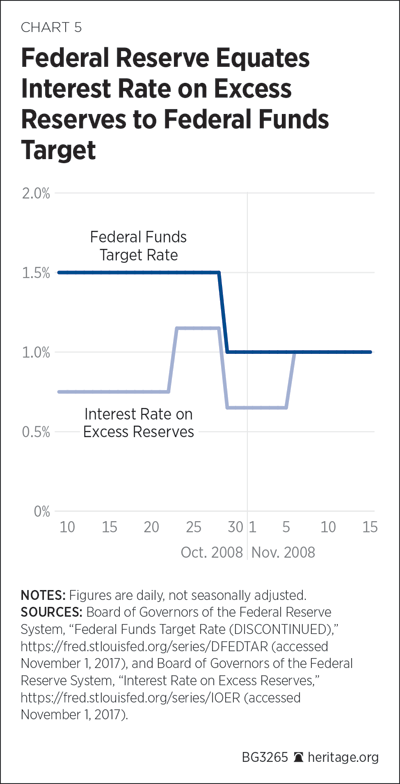
Effects and Implications of the New Framework
When the Fed implemented this new framework, it chose to pay a higher IOER rate than the rate banks were charging to lend in the federal funds market. Unsurprisingly, aggregate lending in the federal funds market declined severely, from approximately $200 billion in 2007 to just over $60 billion by the end of 2012.[REF] Though the Federal Reserve does not provide a continuous data series for the post-crisis era, the total volume in the federal funds market remains below $100 billion.[REF]
The composition of federal funds market lending has also changed dramatically. Whereas banks accounted for the bulk of federal funds lending prior to the new framework (approximately 60 percent), they accounted for little more than 25 percent by the end of 2012.[REF] Now, the GSEs—mainly Fannie Mae, Freddie Mac, and the Federal Home Loan Banks (FHLBs)—are the primary source of lending in the federal funds market.[REF] After 2011, it appears that the FHLBs account for the bulk of this GSE activity, with a share of federal funds lending at nearly 75 percent in 2012.[REF]
These changes represent a completely different dynamic in the federal funds market. Prior to the IOER framework, banks lent and borrowed in the federal funds market to cover their reserve needs. Now, on the other hand, most of the lending in the federal funds market is by GSEs, which do not have to meet the Fed’s reserve requirements. Of course, banks are eligible to earn IOER, so they can borrow funds (effectively) from the GSEs, and then earn the IOER rate on these borrowed funds (at virtually no risk). Thus, while banks are still doing most of the borrowing in the federal funds market, they are not doing so to cover their reserve needs—they are borrowing to invest funds in a risk-free asset provided, at above market rates, by the Fed.
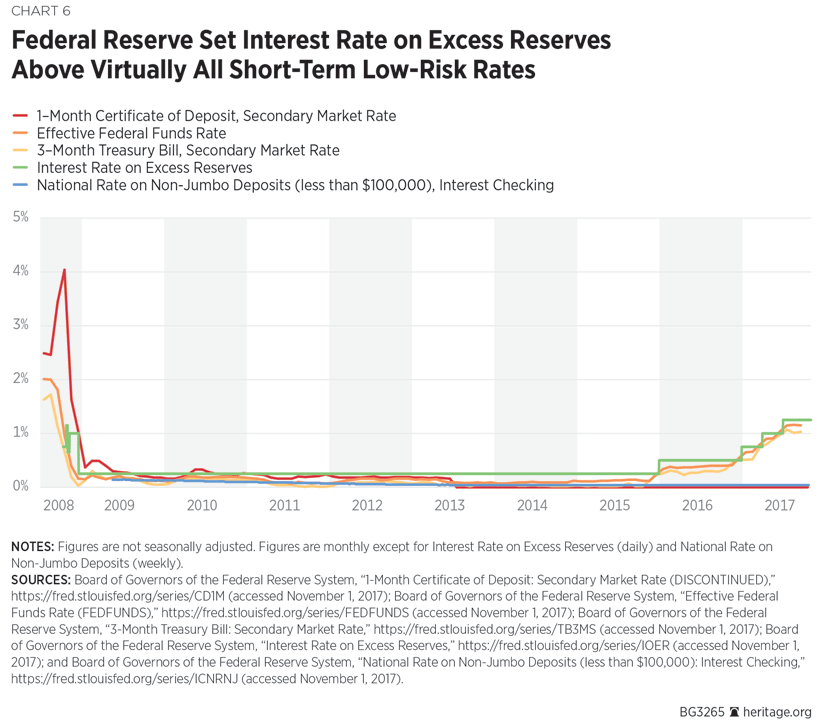
The new operating framework has provided banks with a new risk-free investment choice, at a relatively high rate of return, so it should not be surprising that banks are holding more funds as excess reserves. Naturally, the more banks hold in reserve, all else constant, the less money they create in the broader economy. Even though aggregate lending has rebounded from the financial crisis and subsequent recession, it is clear that the rate at which banks use reserves to create broader money has not.
One way to express this relationship is with the money-multiplier, the ratio of the broader money supply to the monetary base.[REF] This ratio dropped sharply after September 2008 and has remained well below its pre-crisis trend. (See Chart 7.) Balance sheet data from banks also support this interpretation. For instance, from 2008 to 2015, banks began holding a larger share of their assets as cash and a smaller share as loans. (See Chart 8.) This trend appears to have reversed in the past two years, but banks are still holding a much larger share of their assets as cash (almost 15 percent) relative to the share in the pre-crisis framework (less than 3 percent).
Similarly, loans remain a smaller share of banks’ total assets now (less than 57 percent) relative to the pre-crisis share (approximately 63 percent).[REF] (See Chart 8.) The fact that these changes coincide with the Fed’s decision to pay banks an above-market return to hold excess reserves suggests that the Fed has succeeded in keeping excess reserves off the market.[REF] In other words, banks have not used the Fed’s newly created reserves to invest in new lending activity, which is exactly what the Fed hoped to achieve with IOER. The following list summarizes the negative implications that this new framework has for the broader economy:
- Subsidized financial repression. The Fed has created two new risk-free investment choices—above-market interest on excess reserves and the ON RRP program—for banks and other favored financial firms, and it literally administers the rate it pays on these investments. This arrangement is the equivalent of the federal government directly paying favored constituents to keep funds out of the private sector.
- Decreased private investment. The Fed’s new operating policies encourage banks to park funds at the Fed instead of investing funds in private securities and loans. Each dollar of excess reserves held at the Fed represents a dollar that banks fail to invest in the private market, thus detracting from economic growth.
- Credit market distortions. The Fed’s policies have eliminated the federal funds market as a source of bank liquidity and allocated credit directly to the housing and government sectors. The Fed now holds $4.5 trillion in total assets, with approximately $2 trillion of that total in MBS. To put this figure in perspective, the entire commercial banking sector holds approximately $1.8 trillion in MBS.[REF] Neither prices of MBS nor the federal funds rate convey economic information as they have traditionally.
- Increased political risk for the Fed. The Fed’s large interest payments to banks pose an increasing political threat to the Fed’s operational independence. In 2013 and 2014, the Fed paid banks $5.2 billion and $6.7 billion, respectively. The Fed now projects that it will pay $27 billion in interest on excess reserves in 2017, with the amount rising to $50 billion by 2019.[REF] These payments reduce funds flowing to the Treasury and give the obvious appearance of providing generous government subsidies to large banks because the IOER rate is greater than the basic deposit rate available to the public.
- More accessible money spigot. The new framework divorces the Fed’s monetary policy stance from the size of the Fed’s balance sheet. It is designed to allow the Fed to purchase as many assets as it would like, all while paying firms to hold on to the excess cash that these purchases create. This framework can all too easily allow the Fed to be a pawn of the Treasury, enabling the government to run larger deficits. It also opens new opportunities for political groups to pressure the Fed for direct funding.
- Weakened monetary policy effectiveness. Because the new framework replaces market forces with bureaucratically administered rates, it prevents private markets from allocating credit without (potentially massive) ongoing government interference. This arrangement distorts prices and jeopardizes the Fed’s ability to maintain monetary control. That is, it endangers the Fed’s ability to regulate the economy’s overall liquidity so that it can meet its broader economic goals with respect to the general course of spending, prices, and employment.
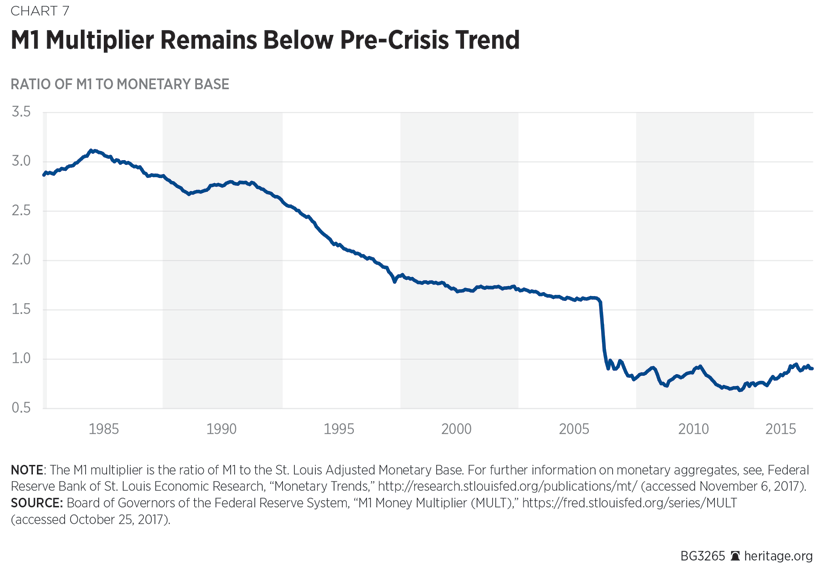
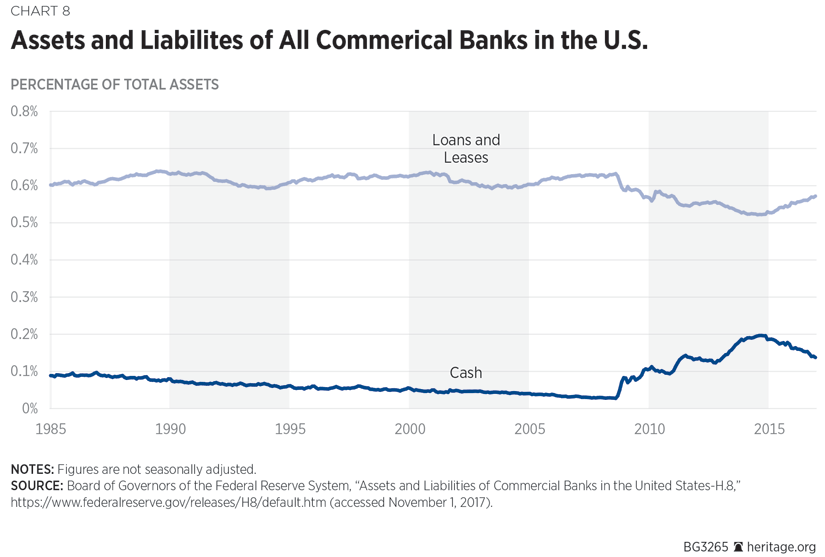
Authorization for Interest on Reserves
For years, the U.S. Treasury successfully opposed the Fed paying banks interest on reserves,[REF] but Title II of the Financial Services Regulatory Relief Act of 2006 authorized these payments.[REF] Even though the 2006 act authorized these interest payments beginning October 1, 2011, the Fed later asked Congress to speed up that date. Congress agreed, and the Emergency Economic Stabilization Act of 2008 accelerated the date to October 1, 2008.[REF] Although the 2008 act accelerated the date of initiation by three years, it left all other statutory language from the 2006 act unchanged.
Because the main intent of the 2006 act was to remove an implicit tax on deposits, it authorized the Fed to pay interest on reserves “at a rate or rates not to exceed the general level of short-term interest rates.”[REF] Nonetheless, the Fed has consistently paid rates on reserves higher than the federal funds rate and other short-term interest rates. As of June 2016, for instance, the Fed was paying an IOER rate of 50 basis points even though the federal funds rate was only 38 basis points. As noted above, the Fed has set the IOER rate above virtually all short-term low-risk rates available on the market for nearly the entire time it has paid IOER.
It is very difficult to argue that such a high premium was what even Fed officials had in mind during 2006, much less what Congress had in mind. However, when Congress questioned Fed Chair Janet Yellen about this seemingly high rate of interest, she intimated that the Fed had the authority to pay even a 100 percent premium over the federal funds rate.[REF] Clarifying the statutory language, so that the Fed can no longer pay above-market IOER rates, should be one of Congress’ priorities in 2018.[REF]
Solutions for Congress
In the wake of the 2008 crisis, the Federal Reserve made trillions of dollars in emergency loans and expanded its balance sheet by purchasing large quantities of long-term Treasuries and MBS. These operations gave rise to an experimental policy framework that replaces traditional market activity with bureaucratically administered interest rates. To normalize monetary policy, thus restoring the market forces that the Fed has displaced, the Fed has to shrink its balance sheet and end these experimental programs.
Though Fed officials have started reducing the size of the balance sheet, the current plan is to reinvest a portion—rather than all—of the Fed’s monthly principal payments in new securities. That is, as the Fed’s securities mature and the Fed receives principal payments, the Fed will buy a smaller amount of new securities with those proceeds than it had been buying. The current plan limits Treasury security reductions to $6 billion per month, and agency MBS reductions to $4 billion per month, through December 2017. These caps will rise each month until they reach $30 billion for Treasuries and $20 billion for MBS, at which time they will become fixed.[REF]
Under this schedule, the Fed’s balance sheet will be approximately three times its pre-crisis size by 2020, and the Fed will surely use any economic slowdown to justify an even slower pace. Furthermore, virtually no Fed officials have seriously discussed (in public) ending the current IOER framework. These facts suggest that the Fed is trying to maintain its existing framework for as long as possible rather than restore its traditional operating framework.[REF] Congress should require the Fed to implement a plan that combines shrinking the balance sheet with phasing-out the payment of interest on excess reserves in no more time (approximately five years) than it took to implement its QE programs.[REF]
Congress should also immediately require the Fed to stop paying above-market rates on reserves. This change merely requires Congress to clarify the statutory language that authorizes the Fed to pay interest on reserves, thus aligning the Fed’s practice with the original intent of the law. In particular, Congress should clarify the meaning of “general level of short-term interest rates” so that the Fed can no longer pay above-market IOER rates. For instance, Congress could amend the law as follows:[REF]
Section 19(b)(12) of the Federal Reserve Act (12 U.S.C. 461(b)(12)) is amended by inserting after Subparagraph (C)
(D) General level of short-term interest rates defined.
For purposes of this paragraph, the term “general level of short-term interest rates” shall be defined as the average value over the preceding six-week interval of the Federal Reserve Bank of New York’s benchmark broad Treasury financing rate on overnight repurchase agreements.
There is no uniform repo rate to use as a benchmark market rate, but the Fed’s broad Treasury financing rate is a reasonable benchmark rate. This rate, developed by the Federal Reserve, serves as a general benchmark rate for the overnight repo Treasury market, where dealers engage in repo transactions collateralized by Treasury securities.[REF] Parking reserve balances at the Fed overnight is risk-free, and these repo transactions are very similar.
Conclusion
Federal Reserve officials have implemented a plan to shrink its bloated balance sheet, but the plan is far from optimal. The current schedule leaves the Fed’s balance sheet abnormally large for far longer than it took to complete its QE purchases, thus leaving taxpayers at risk and maintaining the Fed’s massive credit allocation to the government and housing sectors. Furthermore, the Fed has not yet announced any plans to end its IOER policies and is set to start paying banks an even higher interest rate on excess reserves. To normalize monetary policy without inviting a new recession, the Fed needs to shrink its balance sheet and phase out its interest on excess reserve policies.
Ultimately, there is no way to restore the Fed’s traditional operating procedures unless the Fed stops paying above-market interest rates on reserves. The Fed will have to pay interest on reserves while it reverts to its traditional operating framework, but Congress can still require the Fed to pay typical market rates during this normalization period. To ensure that the Federal Reserve merely compensates banks for the cost of holding required reserves, without making such reserves preferable to other interest-earning assets, Congress need only to clarify the meaning of “general level of short-term interest rates” in its authorizing statute. There is no valid reason to delay ending these above-market payments.
—Norbert J. Michel, PhD, is Director of the Center for Data Analysis, of the Institute for Economic Freedom, at The Heritage Foundation.


